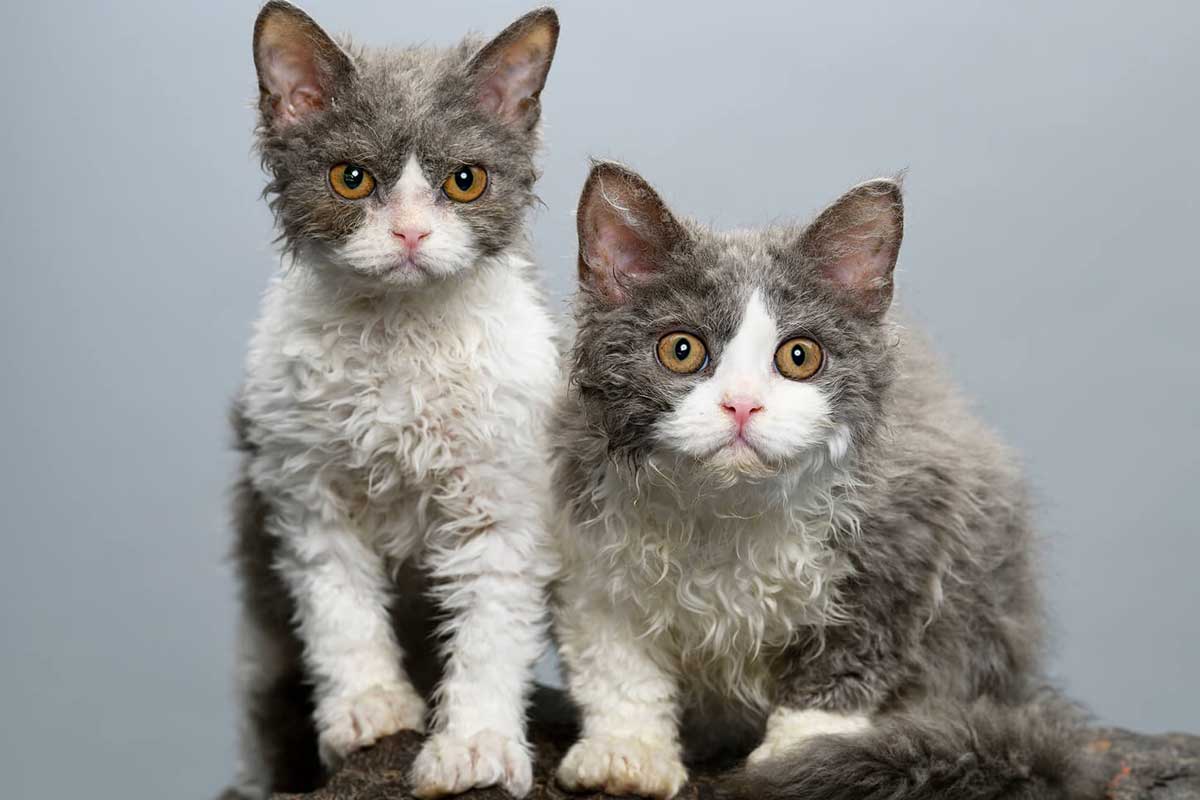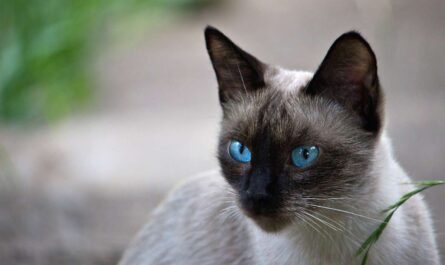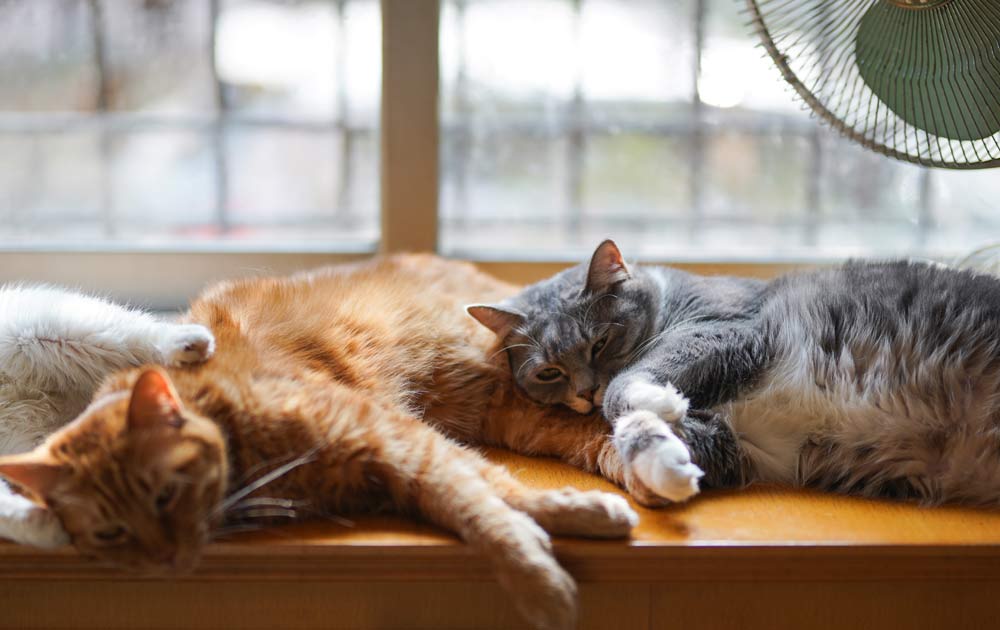Why do cats groom each other? While the sight of cats engaged in play fighting, often accompanied by bouts of grooming, is a natural and healthy expression of their social nature, it’s essential to discern between playful interactions and genuine tension. In instances where genuine tension arises, typically not following the amicable allogrooming, proactive measures can be taken to defuse the situation. The introduction of distractions, such as enticing toys or nourishing food, can redirect their attention away from potential conflicts. Additionally, when necessary, separating the cats temporarily can provide a cooling-off period, preventing escalated tensions and preserving the overall harmony within the feline social milieu.
Social Grooming and Bonding in Cats
Cats exhibit a fascinating behavior that transcends mere cleanliness—social grooming. This intricate ritual involves not only maintaining personal hygiene but also serves as a means of establishing and reinforcing social bonds among feline companions. The act of licking, a fundamental aspect of grooming, is an eloquent expression of affection and camaraderie within the feline community. This endearing behavior is not confined to the realm of domestic cats; it is deeply ingrained in the social fabric of feral cat colonies as well.
In the intricate tapestry of feline interactions, grooming becomes a poignant indicator of the depth of feline relationships. When cats engage in reciprocal grooming, it is akin to a silent declaration of profound mutual affection. This shared act of care and attention goes beyond the superficial, revealing a genuine liking and connection between the feline participants. The grooming ritual becomes a language of its own, a non-verbal expression that transcends the limitations of feline vocalizations.
The Significance of Mutual Grooming
The significance of mutual grooming among cats extends beyond the cozy confines of domesticity. In feral communities, where survival instincts are paramount, the act of grooming is reserved exclusively for members of the same colony. This exclusivity underscores the depth of the social structure within feline communities, where bonds forged through grooming rituals signify trust and kinship. The translation of this concept into the lives of indoor cats underscores the continuity of feline behavior across different environments.
The act of mutual grooming, as explained by Dr. DelGiudice, holds a unique role in the dynamics of feline relationships, especially in the aftermath of conflicts. Post-conflict situations witness the emergence of grooming as a reconciliatory gesture, a non-verbal olive branch extended to mend any rifts that may have surfaced during interactions. This nuanced aspect of feline behavior underscores the sophistication of their social dynamics, revealing a layer of complexity that goes beyond the stereotypical image of aloof and solitary cats.
15 Reasons Why Cats Groom Each Other
Understanding the multifaceted nature of feline interactions is akin to deciphering an elaborate dance. By recognizing the fine line between playfulness and genuine tension, implementing strategic distractions, and, when needed, judiciously resorting to temporary separation, we contribute to the cultivation of a harmonious feline society. As custodians of their well-being, our ability to navigate these subtleties ensures a thriving, interconnected feline community, where playfulness coexists seamlessly with moments of serene camaraderie.
1. Mutual Cleanliness and Health
Beyond the social nuances, the grooming ritual is an essential component of feline hygiene. Cats, renowned for their meticulous cleanliness, rely on each other to ensure that every nook and cranny of their fur is devoid of parasites, debris, or any potential health hazards. In this cooperative grooming endeavor, each cat becomes both a purveyor and recipient of meticulous cleanliness, contributing to the overall well-being of the group. The symbiotic nature of this behavior ensures that every member of the feline cohort benefits from the collective pursuit of cleanliness.
2. Stress Alleviation and Comfort
Grooming transcends the pragmatic realm of hygiene and ventures into the realm of emotional solace. Cats, often solitary by nature, find solace and comfort in the rhythmic strokes of a companion’s tongue. The tactile sensation of grooming, coupled with the release of endorphins, creates a calming effect, alleviating stress and fostering a sense of security within the group. This shared grooming experience acts as a therapeutic balm, weaving a tapestry of reassurance and tranquility in the feline social landscape.
3. Social Bonding and Affection
Cats, those enigmatic and graceful creatures, engage in the intricate ritual of grooming each other, a behavior that transcends mere hygiene. This ritual serves as a potent mechanism for social bonding and the expression of profound affection within feline communities. When a cat delicately extends its tongue to caress the fur of a fellow feline, it is an eloquent testament to the intricate social fabric woven among these mysterious creatures. The exchange of rhythmic grooming motions becomes a silent language, a non-verbal symphony of connection that solidifies the bonds within the group.
4. Identification and Scent Marking
In the olfactory symphony that defines the world of cats, grooming assumes a pivotal role in identification and scent marking. Each cat possesses a unique scent profile, and as they groom each other, they deposit their individual fragrances on the fur of their companions. This aromatic exchange serves as a communal signature, a collective olfactory tapestry that marks the group’s identity. Grooming becomes a sensory language, an aromatic dialect that speaks of shared belonging and mutual recognition.

5. Maternal Instincts and Care
The act of grooming is intrinsically tied to maternal instincts within the feline realm. Mother cats, in particular, engage in extensive grooming sessions with their kittens, not only for hygiene but as a manifestation of caregiving and nurturing. This early exposure to grooming sets the foundation for the social dynamics that unfold as the kittens mature. Grooming, in this context, is a tangible expression of love and protection, laying the groundwork for a lifetime of interconnected relationships within the feline family.
6. Behavioral Synchronization
In the ballet of feline interactions, grooming serves as a form of behavioral synchronization. As one cat initiates the grooming ritual, others often follow suit in a domino effect of social harmony. This synchronized behavior is not only visually captivating but also reflects the cohesive nature of feline communities. Grooming becomes a shared experience, a communal endeavor that unifies the group in a harmonious rhythm of interconnected gestures.
7. Establishment of Hierarchy
Beneath the surface of feline grooming lies a subtle dance of hierarchy. Cats are inherently territorial beings, and within their communal spaces, a nuanced pecking order emerges. The act of one cat grooming another assumes the guise of a hierarchical gesture. The giver, in a gesture of submission, takes on the role of the caregiver, while the recipient, in a position of receiving, acknowledges the dynamics of dominance and submission. This ritualistic grooming, laden with unspoken cues, becomes a harmonious expression of social structure.
8. Cultural Transmission of Behavior
Grooming, as a learned behavior, undergoes a process of cultural transmission within feline communities. Kittens observe and mimic the grooming rituals of their more experienced counterparts, internalizing the social intricacies embedded in this communal practice. Through this cultural transmission, grooming becomes more than a functional behavior; it transforms into a shared tradition that perpetuates across generations, contributing to the continuity of feline social customs.
9. Resolution of Conflict
In the complex tapestry of feline relationships, conflicts inevitably arise. Grooming, surprisingly, becomes a mechanism for conflict resolution. When tensions run high, the act of one cat grooming another can act as a peace offering, a gesture of reconciliation that soothes frayed nerves and restores equilibrium. The tactile nature of grooming serves as a bridge, transcending verbal communication barriers and fostering a sense of unity even in the face of discord.
10. Temperature Regulation
The intricate design of a cat’s tongue is not merely a tool for grooming but also serves the functional purpose of temperature regulation. As cats groom each other, the friction generated by the raspy texture of their tongues stimulates blood flow to the skin. This increased circulation aids in temperature control, particularly beneficial in colder environments. The communal act of grooming thus becomes a dynamic mechanism for maintaining optimal body temperature among the feline companions.
11. Reinforcement of Social Bonds
Within the tapestry of feline social dynamics, grooming emerges as a recurring motif, reinforcing the bonds between individuals. The act of one cat grooming another is a cyclical exchange, a give-and-take that solidifies their social connections. It is not merely a one-sided affair; rather, it is a continuous dialogue of reciprocity that strengthens the intricate web of relationships within the feline community. Each grooming session, like a brushstroke on a canvas, contributes to the masterpiece of their interconnected lives.
12. Communication of Trust
Trust, a delicate currency in the feline world, finds expression in the act of grooming. When a cat submits to being groomed by another, it is a profound manifestation of trust. The vulnerable act of exposing one’s body for inspection and care signifies a deep level of confidence in the relationship. Grooming, in this context, becomes a sacred ritual of trust-building, a silent pact that reinforces the emotional bonds within the feline fraternity.
13. Establishment of Territory
Territoriality is ingrained in the feline psyche, and grooming plays a role in the establishment and maintenance of territory. As cats groom each other within a shared space, they collectively mark that territory with their scent. This olfactory imprint serves as a boundary, a living map that delineates the extent of their communal domain. Grooming, therefore, becomes a communal act of territorial demarcation, intertwining the physical and olfactory dimensions of their shared space.
14. Reinforcement of Social Hierarchy
While grooming can be a gesture of submission, it also plays a role in reinforcing social hierarchies. The dominant cat may assert its position by initiating grooming sessions, signaling its authority within the group. The reciprocal grooming received by the subordinate members is a tangible acknowledgment of their place in the social order. This dual role of grooming as both an act of submission and assertion underscores its multifaceted significance in the intricate dance of feline social dynamics.
15. Prevention of Aggression
In the labyrinth of feline social interactions, grooming acts as a preventative measure against aggression. By engaging in mutual grooming, cats diffuse tension and reduce the likelihood of conflicts escalating into physical confrontations. The intimate nature of grooming creates a shared space of vulnerability, fostering a sense of camaraderie that mitigates aggressive impulses. In this way, grooming becomes a subtle yet powerful tool for maintaining peace within the feline social tapestry.
Can Grooming Cause Problems?
The seemingly innocuous act of feline grooming, while integral to their well-being, unfurls a tapestry of potential complications. From the seemingly benign expulsion of hairballs to the clandestine transmission of viral foes through saliva, grooming emerges as a multifaceted arena where health risks lurk in the intricate folds of a cat’s fur. Vigilance, informed decision-making, and regular veterinary consultations become the guardians in this intricate dance between feline hygiene and potential peril.
Other Interesting Articles
- Cornish Rex Cat Breed: Profile, Traits, Health, Grooming, Care
- Colorpoint Shorthair Cat Breed: Profile, Traits, Grooming, Care
- Cheetoh Cat Breed: Profile, Traits, Health, Grooming, Care
- Chausie Cat Breed: Profile, Traits, Health, Grooming, Care
- Chartreux Cat Breed: Profile, Traits, Health, Grooming, Care
- Chantilly, or Tiffany Cat Breed: Profile, Traits, Grooming, Care
- Cymric Cat Breed: Profile, Traits, Health, Grooming, Care
- Dragon Li Cat Breed: Profile, Traits, Health, Grooming, Care
- Donskoy Cat Breed: Profile, Traits, Health, Grooming, Care
- European Shorthair Cat: Profile, Traits, Health, Grooming, Care
- German Rex Cat Breed: Profile, Traits, Health, Grooming, Care
- Havana Brown Cat Breed: Profile, Traits, Coats, Groom, Care
- Kurilian Bobtail Cat Breed: Profile, Traits, Coats, Groom, Care
- Korat Cat Breed Profile: Health, Traits, Coats, Groom, Care
- Javanese Cat Breed Profile: Health, Traits, Coats, Groom, Care
- Japanese Bobtail Cat Profile: Health, Traits, Coats, Groom, Care
- LaPerm Cat Breed Profile: Health, Traits, Coats, Groom, Care
- Manx Cat Breed Profile: Health, Traits, Coats, Groom, Care
- Nebelung Cat Breed Profile: Health, Traits, Groom, Care
- Norwegian Forest Breed Profile: Health, Traits, Groom, Care


